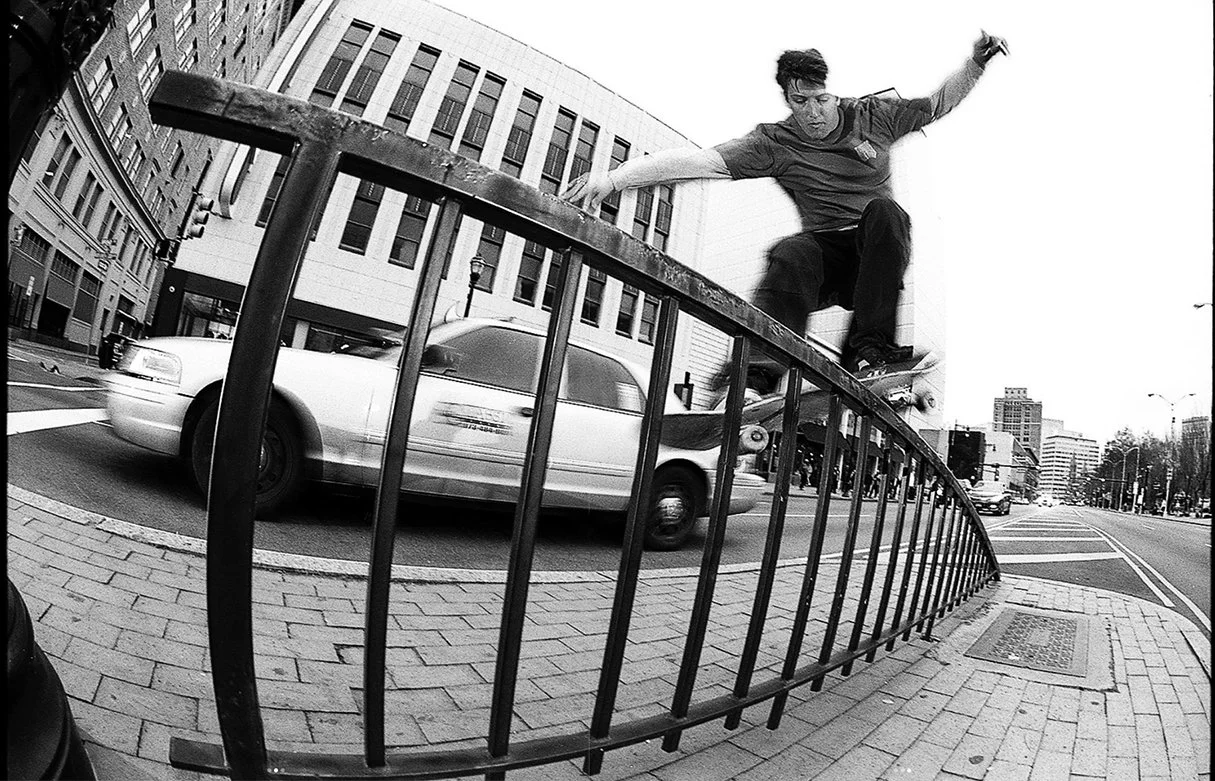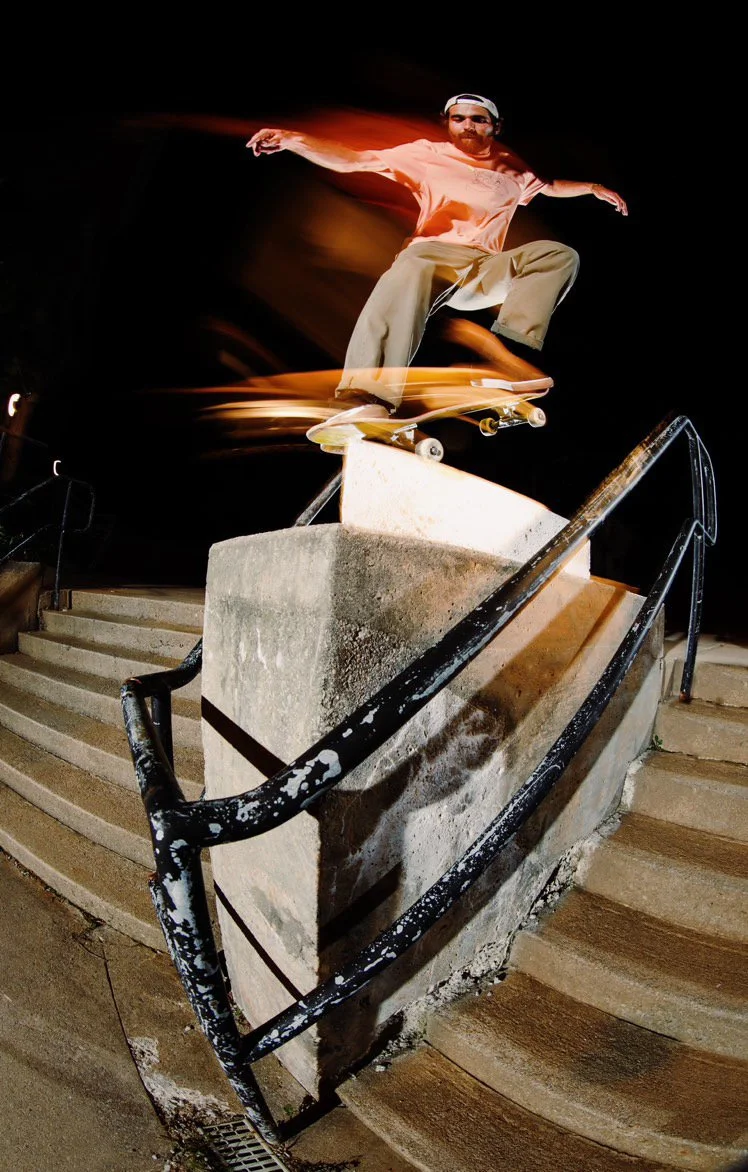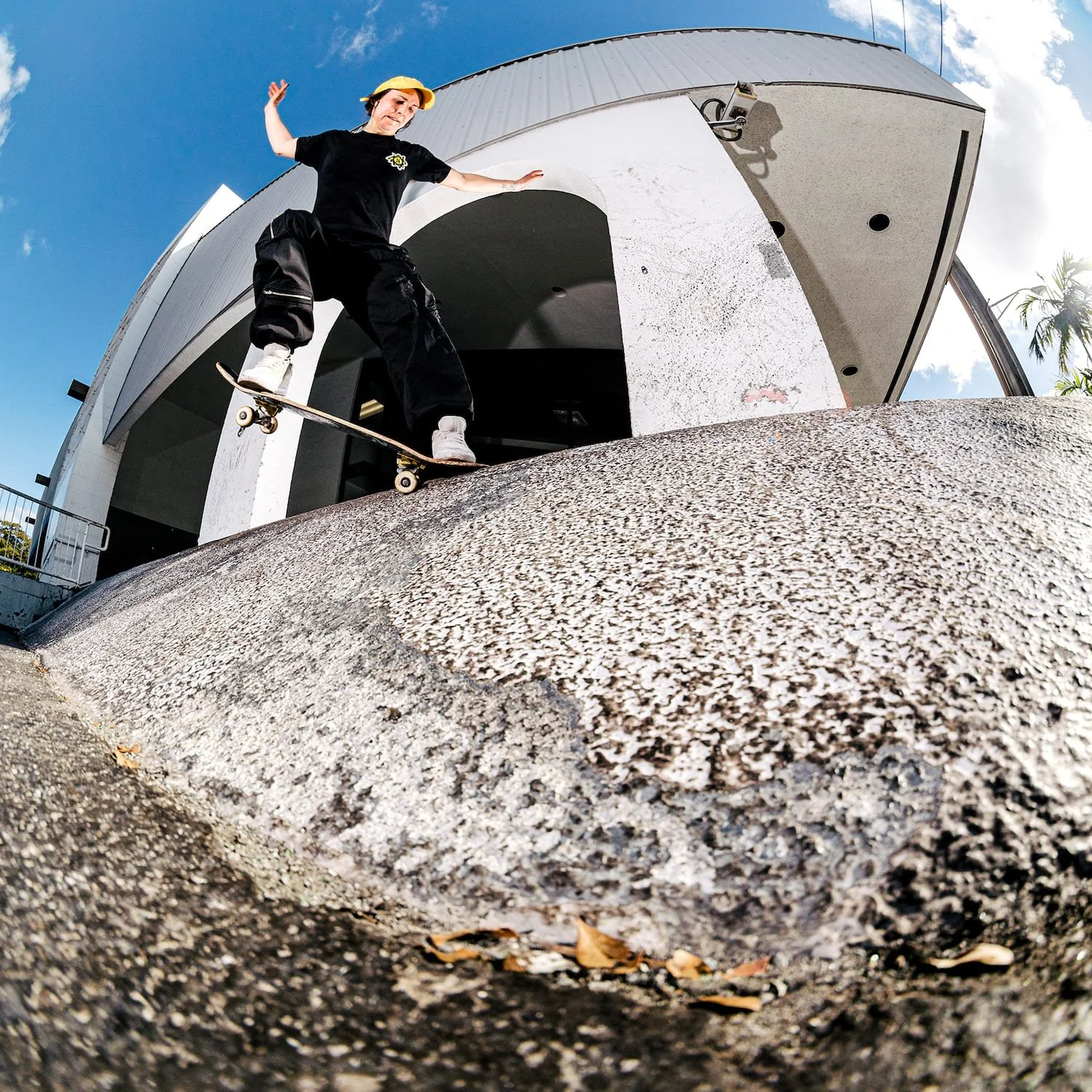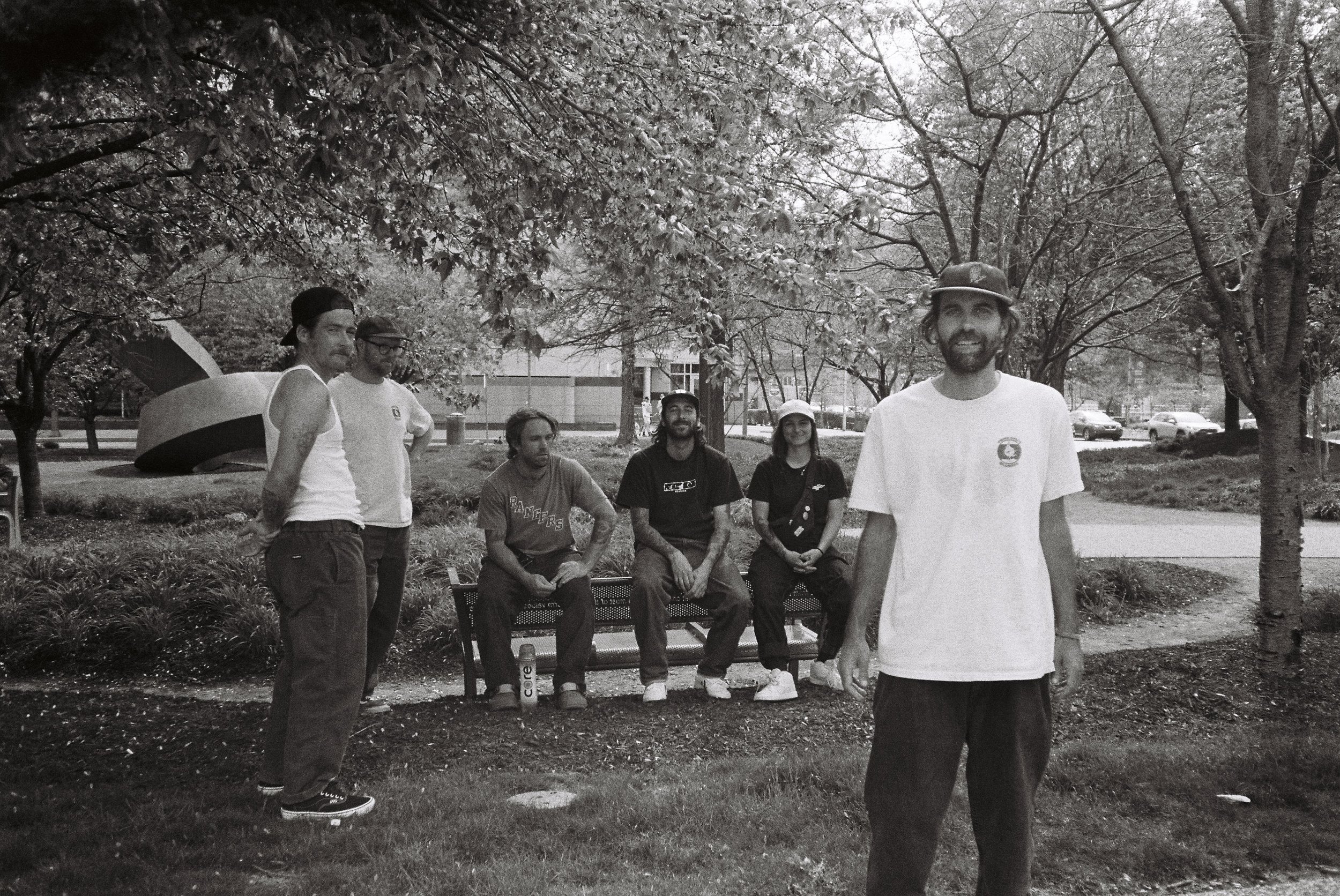Talking Traffic
Luke Malaney, wallride. Photo by Shingo Goya
Why are we even doing this?
Hardgood profit margins are low, media oversaturation makes promotion a challenge for even the most storied of brands, and it’s harder than ever to hold peoples’ attentions. Also, isn’t AI is supposedly going to do everything for us soon? Aren’t many of us supposed to go back working in offices to…make sure this all continues? Or something?
Given the current state of affairs, why bother running a skate brand if your logo won’t be broadcasted to millions of eyes via the Olympics? Why bother taking multiple years to make a video for said brand? We could speculate, but we’d rather hear it from those who are actually doing it. Here’s our conversation with Pat Stiener and Jake Todd on Traffic Skateboards and their latest video, It's Completely Fine: The Toynbee Project.
Tell us a bit about the new Traffic video.
Jake Todd: The video originally was just supposed to be Josh Feist and James Sayres because they had the most footage and James went pro. Of course, if you put a group of guys together and tell them you're working on a video, they're going to want a part.
I definitely think the video definitely could have come out sooner. I pivoted pretty heavy and helped Josh finish Static IV. So that kind of put some things on the back burner for us, but it also helped other people because they got more time to film. Like, Luke Malaney was able to get more things.
Patrick Stiener: I mean, James was coming off whatever footage he had left over from [John] Valenti's video [Free Time] as well. Some of that was HD, but he was going out with VX as well, I think. He started just going down to Philly by himself, and would stay at Jake's on the weekends. He was getting a lot of footage.
Also, we were supposed to try to make a Moving in Traffic 2 using the the same formula as the original: Bob [Puleo] and Jack [Sabback] and then a montage in the middle. As we started filming, I think Jake also had to work on the Static video at the same time So we were just filming on our own with other filmers and then would come back to the project like, now this guy kinda has a part, now this guy kinda has a part. So we might as well just fill it out now. That's kinda how that happened.
What does that mean for Traffic as a whole? Because I see doing kind of a throwback or a nod to what's been done in the past.
Jake: Yeah, I mean my favorite Traffic video is Via. When I was getting the opportunity to do a Traffic video I was like, I want this shit to look, sound, feel like Via. And then I had a couple conversations with Rick [Oyola], just talking full-length videos, and he's like, “Hey I always wanted to get a Toynbee tile as a Traffic tile. I tried it back in the day and couldn't get it to work.” That was kind of like the inspiration around the video: Rick tried this, he wanted to see it, let's see if I can figure it out and make it work for us. It was a pain in the ass but I think we did it. He seemed stoked.
Tell us about the tiles.
Patrick Stiener: The one story I remember is that he drove a car with no bottom in the car and he would stamp these tiles into the ground at stoplights. I'm not sure if that's like an urban legend or if that was accurate — Jake probably knows more than me.
Jake: Yeah, I mean, that's the theory. No one has ever seen him do it, and he was so quick about it. And it was always in intersections or at stoplights. But in the neighborhood where he's alleged to be from, which is in South Philly, like 8th and Jackson, there are all these small test tiles in the street.
Patrick Stiener: That's the theory.
Jake: I'm sure once he really figured it out, he spread. And just like any art, there are imposters. So I'm sure you've seen stuff pop up in New York, Boston, DC, Baltimore, and some of them are just fans. Some of them might be him. No one really knows.
So how did that carry into the video?
Jake: I just think it was something so oddly specific and unique to Philly, and Rick just kind of gravitated towards that and was like, “Yo, we're Traffic, we're Philly, let's try to figure out a way to emulate this.” He tried back in the day, failed, and when we were talking about Traffic videos, he was like, “Dude, you got to figure out how to fucking do the Toynbee tiles, man. That shit would be sick.”
Patrick Stiener: He's been talking about this idea forever. Rick and his homie Mike Gribbin wanted to do it for skate spots, like a spot having one in the ground, I think. I mean, it's been years. He was always obsessed with this Toynbee tile idea.
Toynbee-inspired tiles created for the video. Photo by Jake Todd
Who figured out how to do them for this video?
Patrick Stiener: That's Jake.
Jake: All the originals are linoleum tile, right? But linoleum tile has gotten basically extinct because of asbestos. And it was the perfect material to carve — it's thin and malleable.
So I had to do some research on something similar and I found these, like, eco versions of that tile, but they're more brittle.
So instead of carving into a tile, I'm carving out specific letters and words and then using pieces to fill in and make it look almost like a mosaic tile. It was fucking pain in the ass.
There's actually a Toynbee font that Pat found, thank fucking God, and I would print out people's names the size I wanted them to be. Then I would cut out the letters, put them backwards on the back of a tile, trace them with a Sharpie, and then go in and cut out each letter for each person's name. And then you make a tile on roofing paper and use super glue or crack filler to adhere everything together and then you're cutting up little pieces to go in between all the letters. I did that for however many people are in the video with full parts.
So how did you go about actually stamping them into the ground?
Jake: Hold on one second. [Pulls into drive thru] Can I just get the black iced coffee and the queso y guava tequeño? Thanks.
Sorry, what was your question? How do I stamp them? (Laughs)
Yeah.
Jake: I tried to put two in the ground, and it never seemed to work. It has to be really hot, so it sinks into the ground. You have to cover the whole tile in tar paper and that black crack filler that gets all sticky on streets in the summer. You know what I'm talking about?
I tried to put in a few and run it over with my car and park my tire on it, but it would never stick. So for the most part, I would just trim them to a tee so it looks natural and sits flat, and I'd just shoot super eight and move them as I go and kind of create environments for them.
Patrick Stiener: You need freshly paved ground [to fully stamp a tile in].
Chris Teta, frontside smith grind. Photo by Richard Hart
How long did it take to make the video?
Jake: About three years. The first tile I made, I had it say 2021.
Coming out of Third Shift, Josh Feist already had a good grip of footage that we saved specifically for a smaller project. Then, James Sayres was coming down to Philly a bunch and getting a lot of footage.
Patrick Stiener: That was supposed be Moving in Traffic 2.
Jake: Yeah. Luke came in a little later. [Kevin] Coakley was like, damn, you guys are filming a full length? I want a full part. He started going crazy, filming a bunch. And then Andrea [Bethke] got on and then she was like, well, if you guys are making a video, I want a good chunk. So she started filming a bunch.
Andrea's new. What brought her onto the team?
Jake: She's been in Philly for a minute. She's always been the downtown girl ripper, even though she doesn't want to be known as, like, a good girl skateboarder. She's like, dude, I just want to be like anybody else on the team. Don't say I'm the best girl, don't say I'm the girl that does that. She skates like everyone else. She skates cutty shit, she can skate downtown, Muni, she's like looking for [cellar] doors and shit. She has the Traffic sense, and I've always kind of thought she should ride for Traffic. So yeah, the timing was right, and I was like, yo, let's get you in here.
Patrick Stiener: We went on a road trip and then she got in the van with a bunch of us and it was just natural. She fit right in. So it was like, all right, this is good.
How could you tell she passed the test? Do you guys vote?
Kind of, yeah. You don't ask people questions, but if everyone's like, “Yo, Angie's super dope, she's so sick"", it's like…perfect. If someone were to hit me up and be like, “Yo, Angie kind of was weird or she did this or that kind of sucked”, I'd be like, “that's a bummer.” But everyone hit us up and was like, “Yo, yeah, she's the one.”
Kevin Coakley, backside nosegrind. Photo by Dakota Mullins
How do you stay true to the Philly look/feel while also making something original?
Jake: [Ricky Oyola] kinda set that spot seekers, skate different shit, look for new shit vibe. And when I got asked to do the next Traffic video, I wanted to emulate that as best as I could, and also involve everybody else as much as I possibly can. Feist kind of has that Rick mind of, like, finding new shit, fixing up new shit, trying shit that's in front of your eyes that no one can really figure out. So I kind of just wanted to keep that torch burning and that part of Traffic that Ricky kind of set up.
Patrick Stiener: He’s definitely the torch-bearer of that old ethos. You have to evolve, but we still have that same foundation.
Jake: We'll also go to Albany Plaza. It's not like we're one thing.
How do shops and people who buy the boards perceive the brand?What is the perception when you talk to skate shops and you talk to people who buy the boards? Like, what comes through?
Patrick Stiener: Most of the people buying Traffic are well aware of the image and are usually fans of Ricky as well. They know we're street skating. Kids aren't buying Traffic, you know? The only people buying Traffic already know what it's about.
Jake: Sure, but I think that's like the great part about getting Andrea involved. She'll show me DMs or text messages from girls across the country that are like, “You ride for Traffic? I wasn't sure what that was, but I just watched all their videos and it's sick. They're all VX and they're all skating cool, cutty spots. Where can I buy one?”
You know the typical Traffic fan: late 20s, early 30s, they've always liked Ricky and cutty stuff and underground brands. But I think that's kind of the great part about now — James is younger and skates Plaza and has friends everywhere. Andrea's a girl and skates downtown Philly and Plaza too. Then you also have Feist who's older and a dad and making spots and doing gnarly shit. So now it's kind of transcended what it was. But I think the same old fan remains true at the end of the day. It's not like we're making something that's not for them anymore.
When it comes down to it, we're making the video for us. And you just hope people gravitate to it after you're done.
Where do you see Traffic going in the future?
We’ll always remain true to longer-form content. We're already working on another project — this time it's not gonna be a full-length. It’ll be a Moving in Traffic vibe. But I think remaining true to yourself and your roots is very important, and hard goods, as everyone knows, is fucking tough.
What's tough about it?
Jake: I mean, the cost of boards is up, the margins are shit. There are a million other board brands right now, and sticking out on the wall and connecting with people via Instagram these days is harder and harder. If we wanted to, Traffic could put on those marketable people — the Instagram person, the contest kid — and hit certain things, but that’s not why it was started, that’s not what we’re about.
I mean, you've already seen it — brands similar to us have gone under this past year, like Scumco and Alltimers.
What were you saying about connecting with people on Instagram?
Jake: There's a thousand board brands right now, and we make content that takes a year or two to get to where we want it. On Instagram, you can try as much as you can to connect the story to fans or new people, but it's tough.
You don't want to vomit on the feed — here's an iPhone clip, here's an iPhone clip, here's an iPhone clip. You want everything you do to be special, not just like, we need a post a day to keep eyes on us. If you do everything right, you don't have to. Go look at Quasi's Instagram. They basically only post when they put out a full video or a new season. And you know, I work at a skate shop, I work at Nocturnal, and that brand is always flying off the shelf.
Patrick Stiener: It's also hard for us because we're the only ones doing it. Some brands have full-on social media meetings and schedules of when things are supposed to be posted. We'll not post something in a whole week and be like, shit, we haven't posted in a week.
Andrea Bethke, fakie crooked grind. Photo by Mike Heikkila
Do you have meetings every week, every month? What is it like to run Traffic within Theories?
Patrick Stiener: We do have meetings, but they're not specifically designated for Traffic or whatever. It's just kind of open.
Jake: I feel like it’s kind of like how Crailtap is run. It's like, okay, this next two years, we’re working on a Girl video. They all focus on that. Okay, this next year, we’re working on a Chocolate video. They all focus on that. It's similar here. At the end of the day, we're only so many people.
Patrick Stiener: Yeah, it goes in waves. If we're all working on Traffic, that means no one's working on the Theories video and vice versa. So they all have to take turns.
Do you have a catalog you have to get done every quarter?
Patrick Stiener: Yeah, I mean, we still have seasons that we're trying to hit. We have spring ‘25 coming up, so we'll definitely have meetings on that and go over what we're trying to offer. But you also have to read the room, and right now things are so slow. So we'll maybe make the line smaller if [no video] is coming out for that drop, but if we have a video coming out, we’ll try to make a big line to go along with the video.
We’re hitting all the targets we can, but at the end of the day, it's still just skateboarding. These videos just happen once people start getting clips and then you're like, this is cool, we need to keep this going. It's not like, we have to have a video out by the end of 2025. I don't think that's ever been said for Traffic.
What's Ricky's involvement these days?
Patrick Stiener: Not much. I mean, he's in our group chat and he chimes in here and there, but realistically, Jake and I are doing most of it. I mean, Ricky's Rick. He's still always down, he's involved, but he's not deciding the color of a tee or a board graphic.
What keeps Traffic going?
Jake: I think honestly, at the end of the day, it just comes down to the want to make video projects and present skateboarding through our eyes. Honestly, just the friendship between everyone. As corny as that sounds, everyone's super close.
And also, James can just be like, “Hey, I’ve got this idea for a board.” Everyone just can throw their ideas into the hat and see their, like, niche reference come to life.
Kevin Coakley, kickflip into bank. Photo by Dakota Mullins
Patrick Stiener: Yeah, there's a lot of that. It's so small. It's just an outlet that we all have. I've only ridden for Traffic for my whole life, basically. We can come up with ideas and then we're the ones that put them out. We don't have to go to anyone else for approval. It's like, you guys want to do this?
Who picked the music?
Patrick Stiener: That was mostly me. We definitely wanted to start with the bagpipe song, becauseVia ended with the bagpipes. And that was a Rich [Adler] pick. I didn't want to do it in the beginning because of Mindfield, but we went with it.
There was a lot of collaboration — I picked a lot of music with the riders.
Let's just get it out of the way: Coakley callback song.
Patrick Stiener: Yeah, well Kevin wanted to skate to that song his whole part and I was like, that's too much. I was like, let's just do a little ending section of spots that are kind of Make Friends With the Colour Blue-style. All those into-bank type style spots.
The song is a Black Lips live version. It’s funny that Black Lips are in a Traffic video, but it worked.
Was there a philosophy for what you wanted to do with the music?
Patrick Stiener: It's kind of like what you said earlier about taking the original formula and expanding on it in a modern way. It's not all going to be weird, instrumental, jazzy stuff. We can take those elements, but also have an actual hook or vocals. The Grace Jones song still sounds super cool and can fit into that vibe, but it's more modern sounding, even though it's an old song.
Tell me the story of where the team is at right now.
Jake: I feel like Traffic's a brand where, once you're in, you're in for life, as corny as it sounds. For example, Sean Williams had a bunch of clips in the montage and he was the first person that Ricky ever gave boards to.
He was just a kid from Jersey, basically, and he was on Traffic in the early days and was inVia, all that stuff. I don't want to say he fell out of love with skating, but I think he hit a point in his life where it wasn't the main focus. He's always been really good. I was talking to him saying, “Dude, I want you to have stuff in this Traffic video.” He was super down. We got a bunch of stuff at the last minute.
He’s like, “Really? I don’t know… maybe that would be cool.” And then the video comes out and he's like, “Hey, 8.0s, you think I could get some?” I'm like, dude, yeah, of course, man. So it's sick to have Sean back in the mix. I always want to get a [Mark] Wetzel clip, a Ricky clip. I would have loved to have gotten a [Jack] Sabback clip or a Rich clip.
The Traffic Squad assembled in Pittsburgh. Photo by Jake Todd.
I think the mentality that Traffic started on is kind of lost in skateboarding today. A healthy amount of gatekeeping, you know what I mean? Where it's like, I actually found this spot. I'm not going to post it on Instagram. I'm not going to bring a bunch of people to it. It's kind of harder to find people that are still like that these days. So I think we've done a pretty good job on getting Josh Feist in the mix. We’ve got Justin and Nate Grzechowiak from Buffalo. Andrea, she's like that too.
So it's kind of like, how do you find the healthy balance of people that still think that way, but also can be a presence on social media to play like the game, as they say, and are connected to like a dope shop? I think we always try to get some old and some new. I think that's how you move forward in a video or a brand.
How has that mentality changed? Is social media responsible?
Jake: Something I’ve noticed recently is that kids will go to a spot — a very cool, in-the-cut spot — and film an Instagram clip on it. And it has street signs in it, it has the building name in it, and post it.
Then you're like, damn, what else did you film on it? “No, I just got an iPhone clip there.” That's weird to me. Like I think the first time someone's seeing you skate something on a very cool and unique niche spot, it should be in a video part and not on the internet for me to forget about two scrolls later.
Josh Feist puts in a lot of work and makes spots. And he knows people are going to find them, he wants people to find them, wants people to skate them. He's not doing it for himself. But at the same time, if he's putting in the time, if he's putting in the money and he gets a trick, he’s just like, hey, keep it off the Internet until my part comes out.
Or he’ll plan things out methodically where it's like, okay, I'll fix this spot, then I'll get the clip on it next weekend, and then the video comes out in two weeks. So I'm preventing it from getting blown out. But at the same time, someone could find it. Anyone could find it and just put it on the internet and ruin that little surprise that we hold near and dear. But you know, maybe other people just don't give a shit.
Andrea Bethke, backside disaster revert. Dakota Mullins
Patrick Stiener: Yeah, the spot is the trick sometimes. Everyone can back tail the ledge, but if you found the perfect ledge that's out of a cellar door into something unique, then that's the trick. So if someone else does it first, then it kind of sucks. I don’t think people even care anymore.
Tell me how the more recent riders have become involved.
Jake: I'll try to reiterate and summarize. Josh Feist was just someone that I grew up filming with since I was a kid. I filmed his first video part. So, you know, you always think your friends are the dopest, and I always thought he'd be a sick rider for Traffic because he doesn't go on Instagram and post a bunch of stuff. He makes video parts, makes spots — a perfect fit on Traffic.
With Andrea, she had a different board sponsor that I don't think she was too psyched on and she made a comment to me like, “Hey, if I could ever do this, I'd be so stoked on it.” I was like, “Dude, yeah, this makes 100% sense. Let’s make it happen.”
How involved in Traffic are some of the riders who aren’t around as much? I would take it somebody like Mark Wetzel maybe gets a couple tricks.
Jake: Well, Wetzel actually does a lot of our graphics. So he's pretty involved.
Patrick Stiener: Mark and I are always emailing. He's always sending in artwork and then we're figuring out which ones could work where and for who. So he's involved in that aspect almost more than the skating, but he's always skating on his own. He’s in Toms River, New Jersey. You'll see him on Instagram, filming himself, and then I'm like, fuck, can we just go back and film that for the video?
Jake: I would say maybe 50% of the time it's just, like, throw something in the group chat: this would be sick, this would be funny. Or Pat's like, you know, what do you guys think about this? Pat works with James [Sayres] and Luke [Malaney] a lot on ideas. Then Pat and I bounce back a lot of stuff too.
What's Traffic's reach in Japan like?
Patrick Stiener: I mean, it's pretty big. They had that old tour video Tokyo Transfer. Deshi [Yoshihiro Ohmoto] was on.
So you guys have a distributor in Japan, I take it?
Patrick Stiener: Yeah, Bigwing. That's how Hiroki [Muraoka] got on. But Hiroki is an incredible skater. Like, it wasn't a distribution hookup. Japan, they’ve always loved the Northeast skating.
Where does this video fit into skateboarding?
Patrick Stiener: You could watch this video and then watch Third Shift and you could watch Via and you could watch Look Left or Moving in Traffic. You could watch them all back-to-back and they would all make sense together. That's kind of a goal, I think.
Jake: We used to do Underground Skater of the Year. It came to a point where it's like, wait, this kind of doesn't exist anymore because everyone has an iPhone, everyone has Instagram, everyone has a filmer that's working on parts — everyone's kind of hooked up in one way or another. So it's kind of funny that, you know, the quote unquote ‘underground’ doesn't really exist in skateboarding anymore because everything's so well seen. You can't really even say we’re an ‘underground’ brand or anything like that. We're just doing what we've always done. If you get it, cool. If you don't, there's 100 other skate videos you can go watch.
I wonder how what you guys are doing translates to people who are just getting into skating in the post COVID world.
Jake: At the end of the day, we're making videos with our friends, and that's what is fun about skateboarding. There's not an HD camera with three angles and a photographer. It's just a VX, your friends in a city, and picking out some cool music. And I think that's probably the most relatable thing to anyone picking up a skateboard or thinking about doing something themselves.
Patrick Stiener: That's like the Velvet Underground quote. Everyone who listened to the Velvet Underground started a band because it was so accessible.
Jake: Hey man, everyone that watched Via went to go make their own video.
I have a funny side bit about the music. So this kid — he's not a kid, he's someone my age that I've known through mutual friends for years — came into the shop the other week and he was like, “Dude, Jake, I watched the Traffic video. What the fuck? It was so good!” I'm like, thanks, man. And he's like, “The music, dude. If I knew you listened to good music, I would have tried to be your friend 10 years ago!” I'm like, sick, man, thanks. Maybe you want to be Pat's friend, not mine.
Patrick Stiener: I learned so much about music from skate videos when I was a kid. Now when you watch new skate videos, the music is like an afterthought, where to me, it’s like the most important part. Not the most important, but you associated the tricks with the song. You leave with the song in your head, you know? I can still hear a song and know what tricks were done to it.
All the songs in the video, practically, are edited as well. Like when we're editing the video, we'll actually cut the songs apart to make it make sense to the skating. So if you listen to any of the songs in the video, that's not how they're going to sound. There are whole verses missing.
That's not done that much, is it?
Patrick Stiener: I doubt it.
Jake: I feel like especially in today's age, the style that everyone films HD in is like a lot of run-up and a lot of roll away. So when you actually put a five-minute song on a timeline with people's footage, it might be 25 HD clips. The way we edit and we like to see skate videos is more fast-paced. So it ends up being way more clips.
Patrick Stiener: That's why Kevin has three songs. Because I'll be like, this song gets boring after a minute 20. So after a minute 20, this song's no more. It's no good. Let's chop here. Then you're constantly feeling something.
Jake: I feel like Peter [Sidlauskas] would always do a good job of that with Bronze videos, where he would take someone that had, like, two minutes of footage, and give them two or three songs. It's constantly keeping you engaged, because something's always changing. It would make you feel like someone had a part in something that might have been, at the end of the day, not that much footage.









